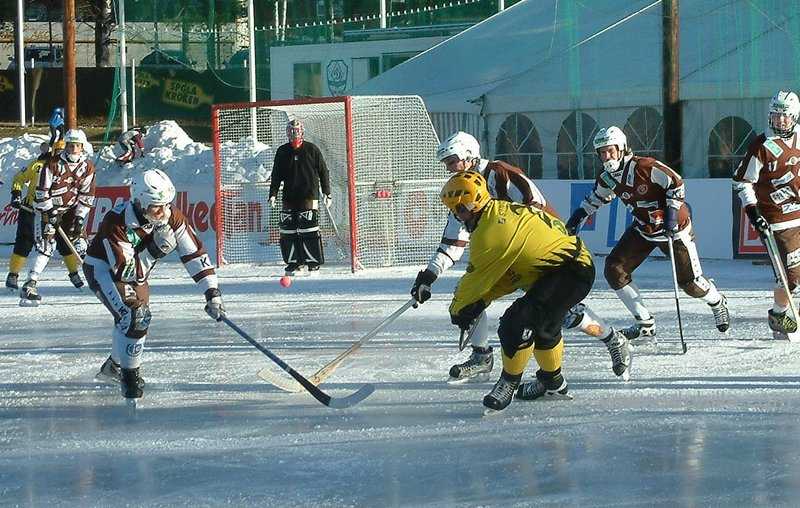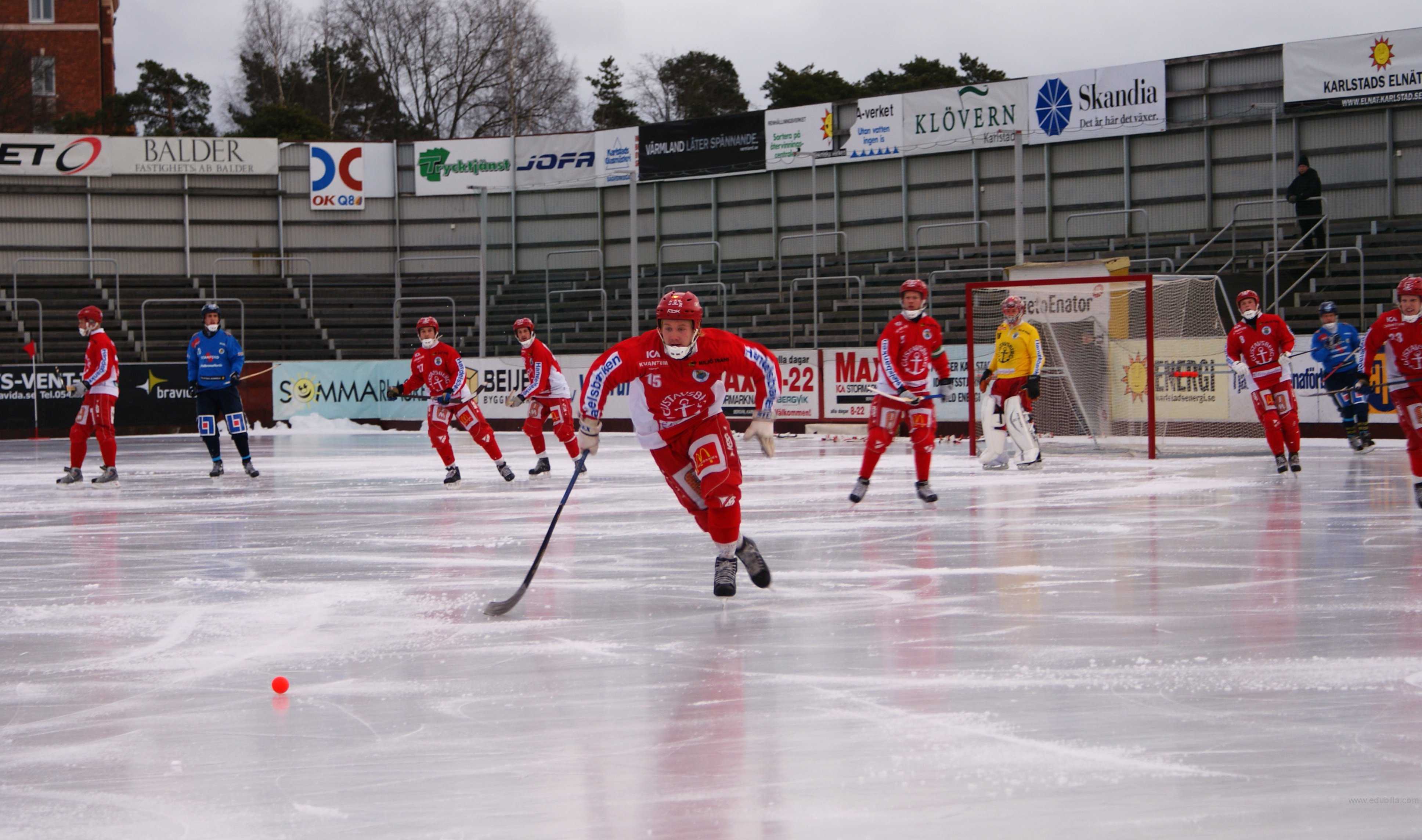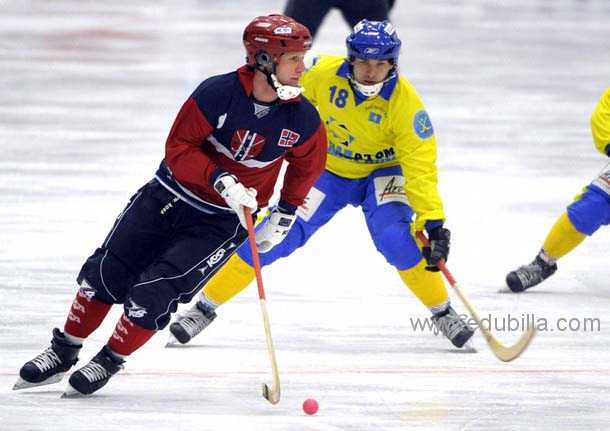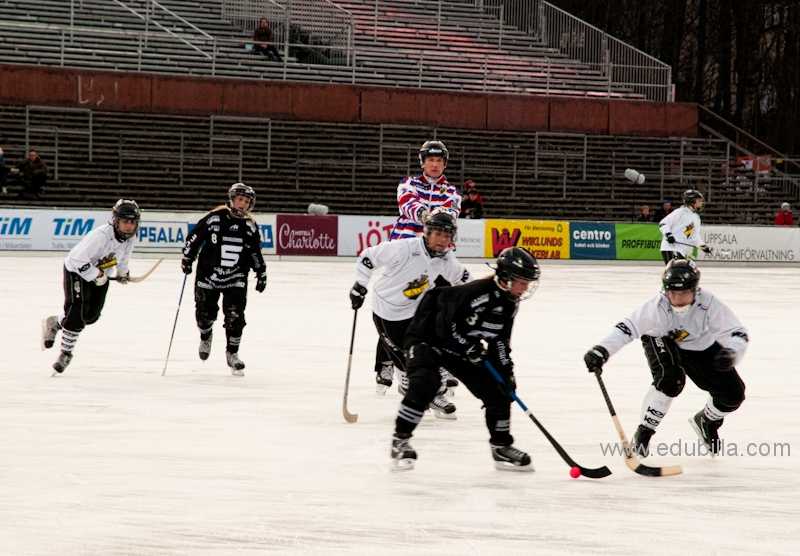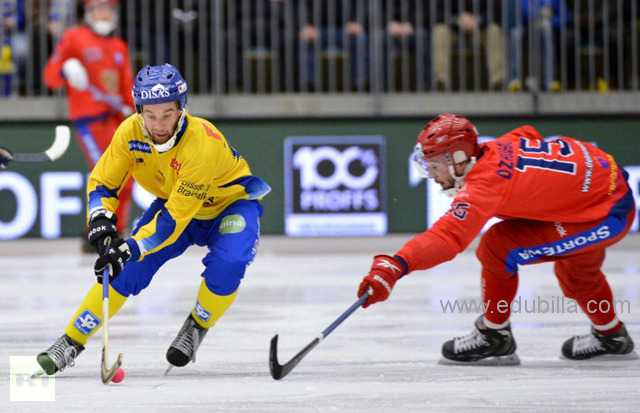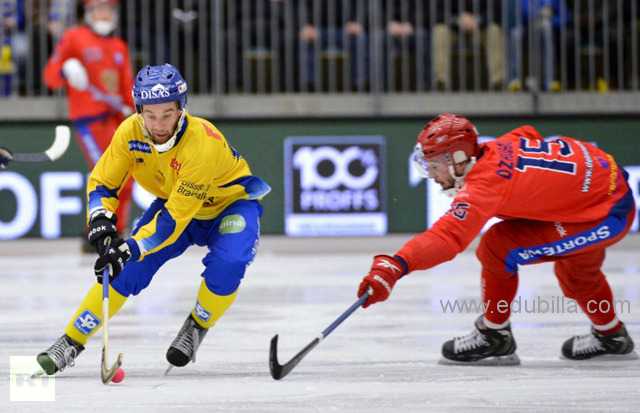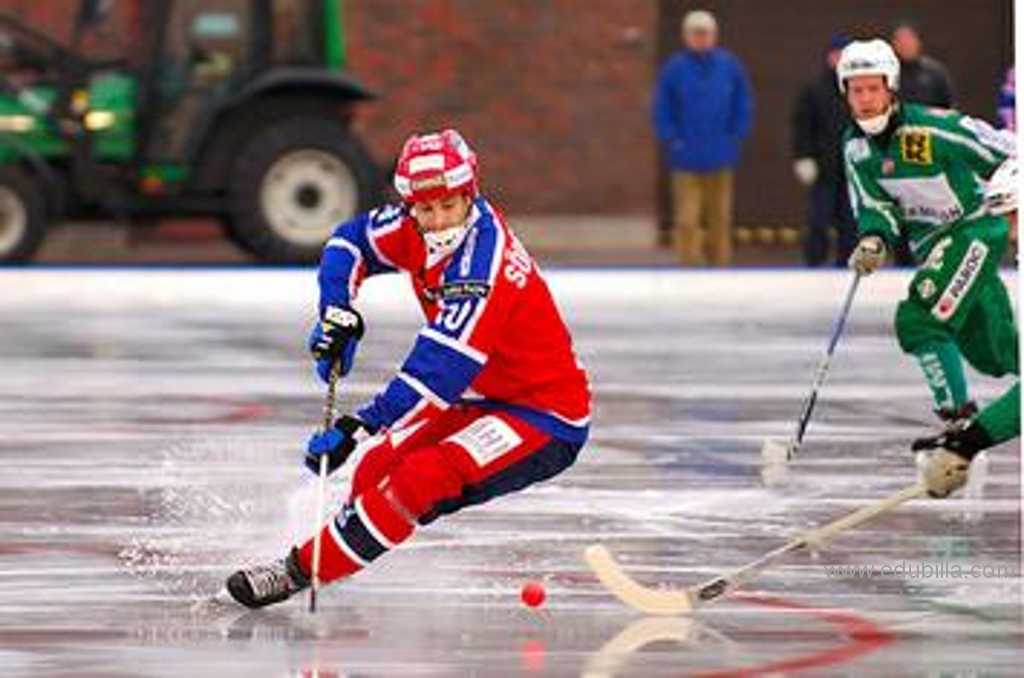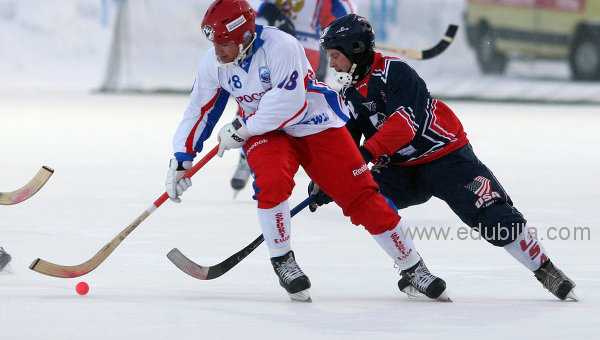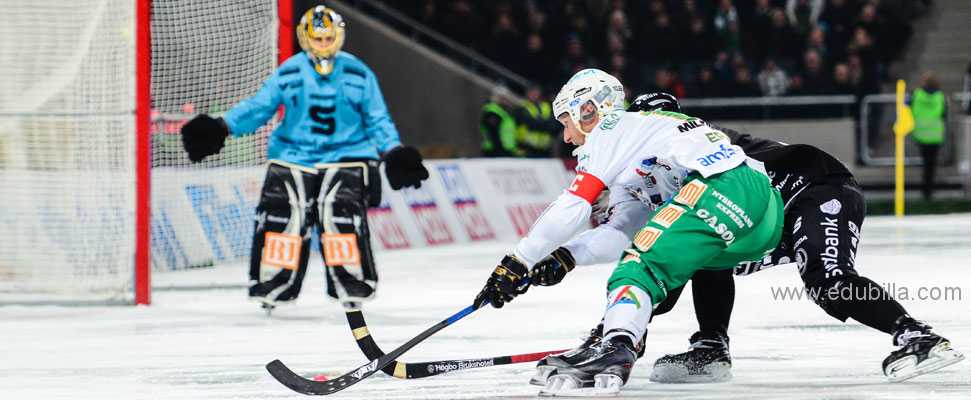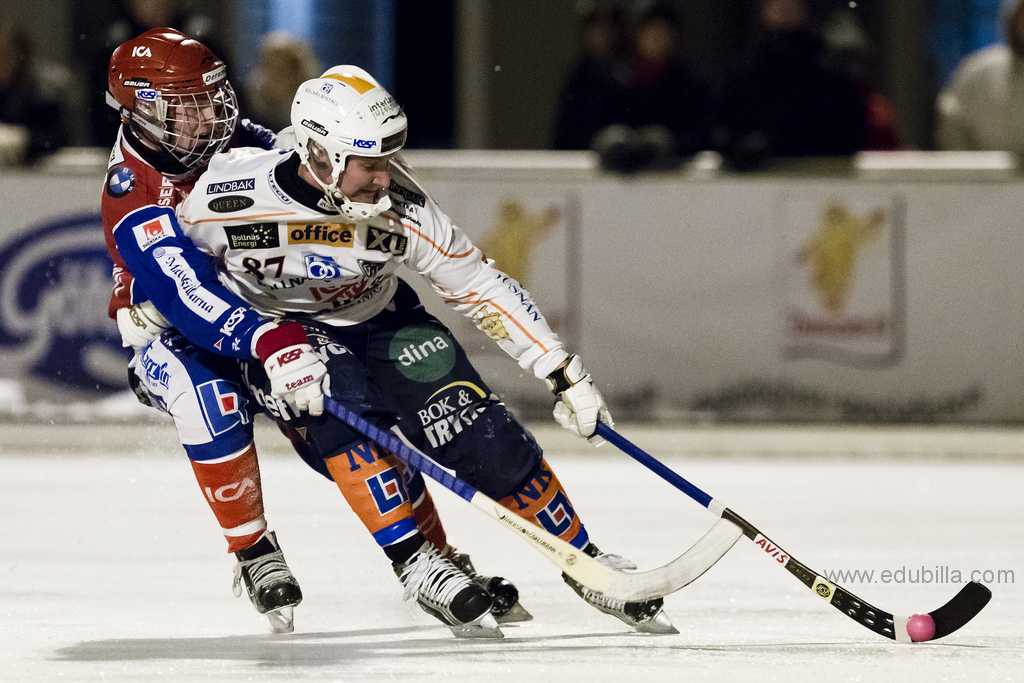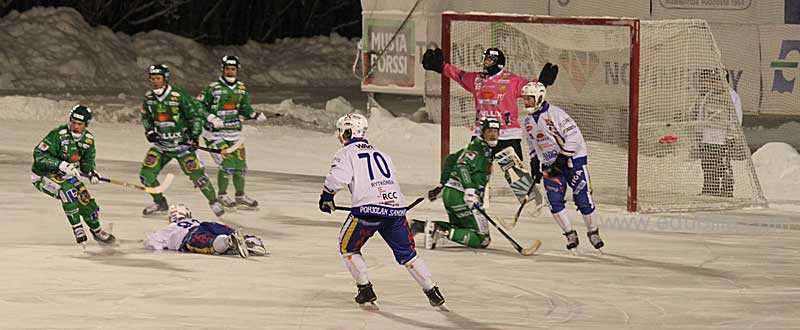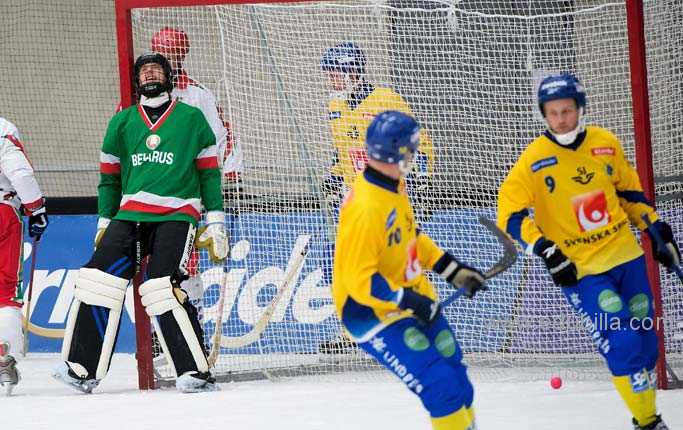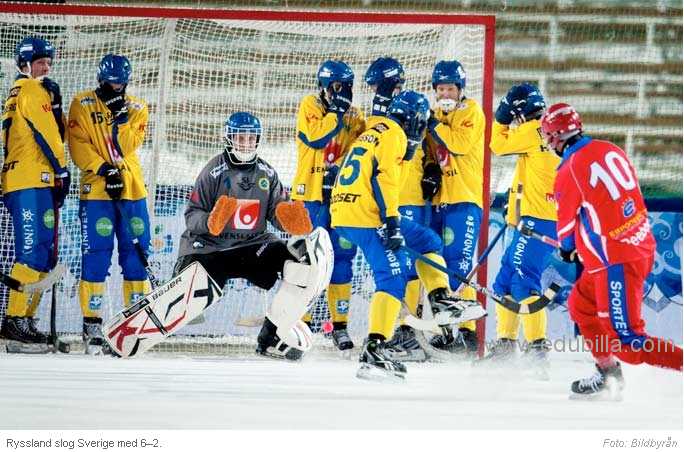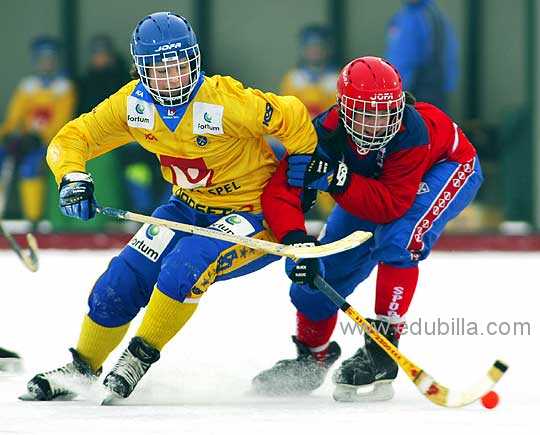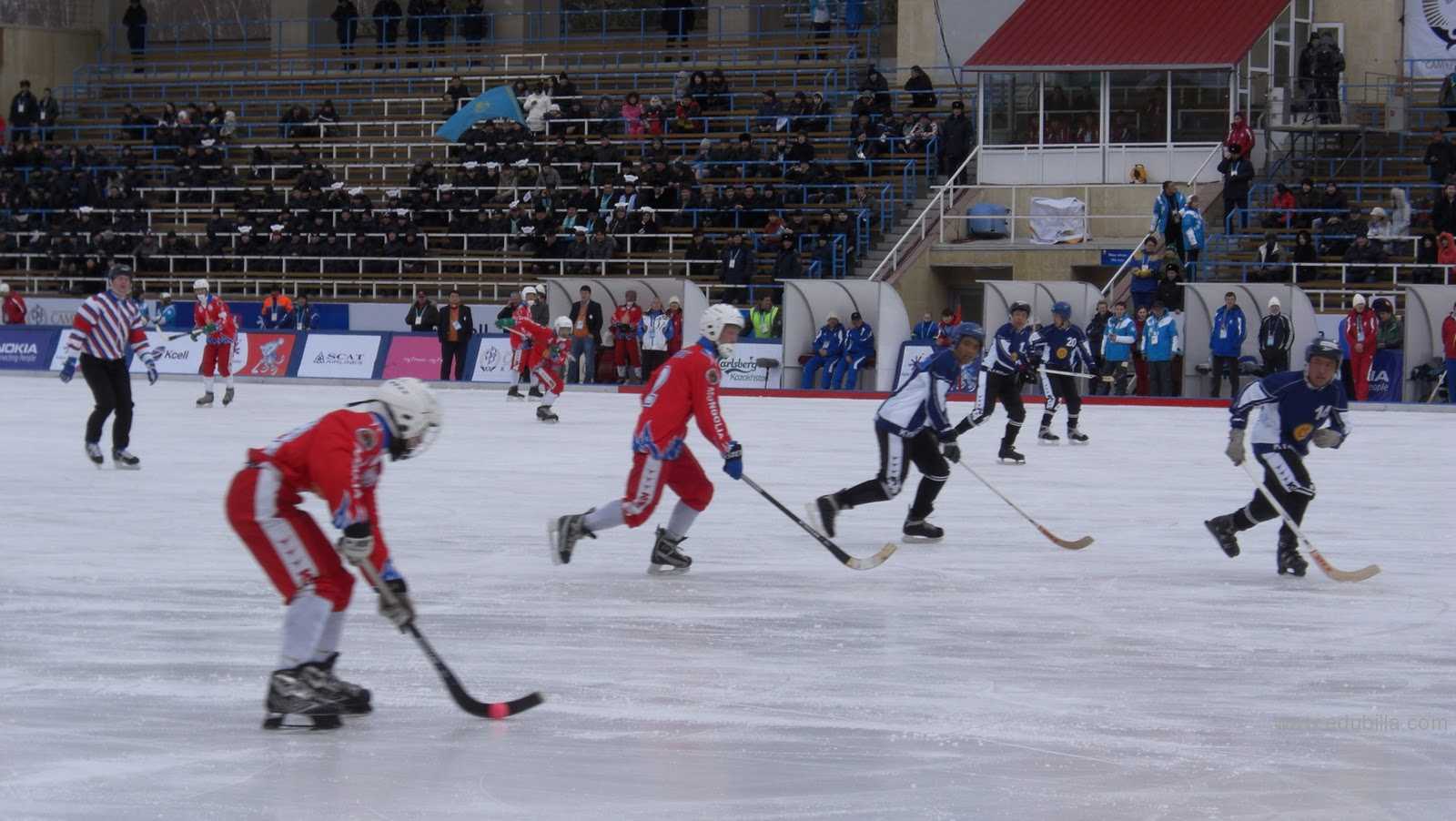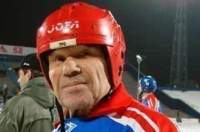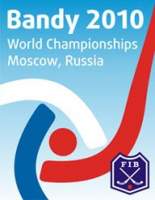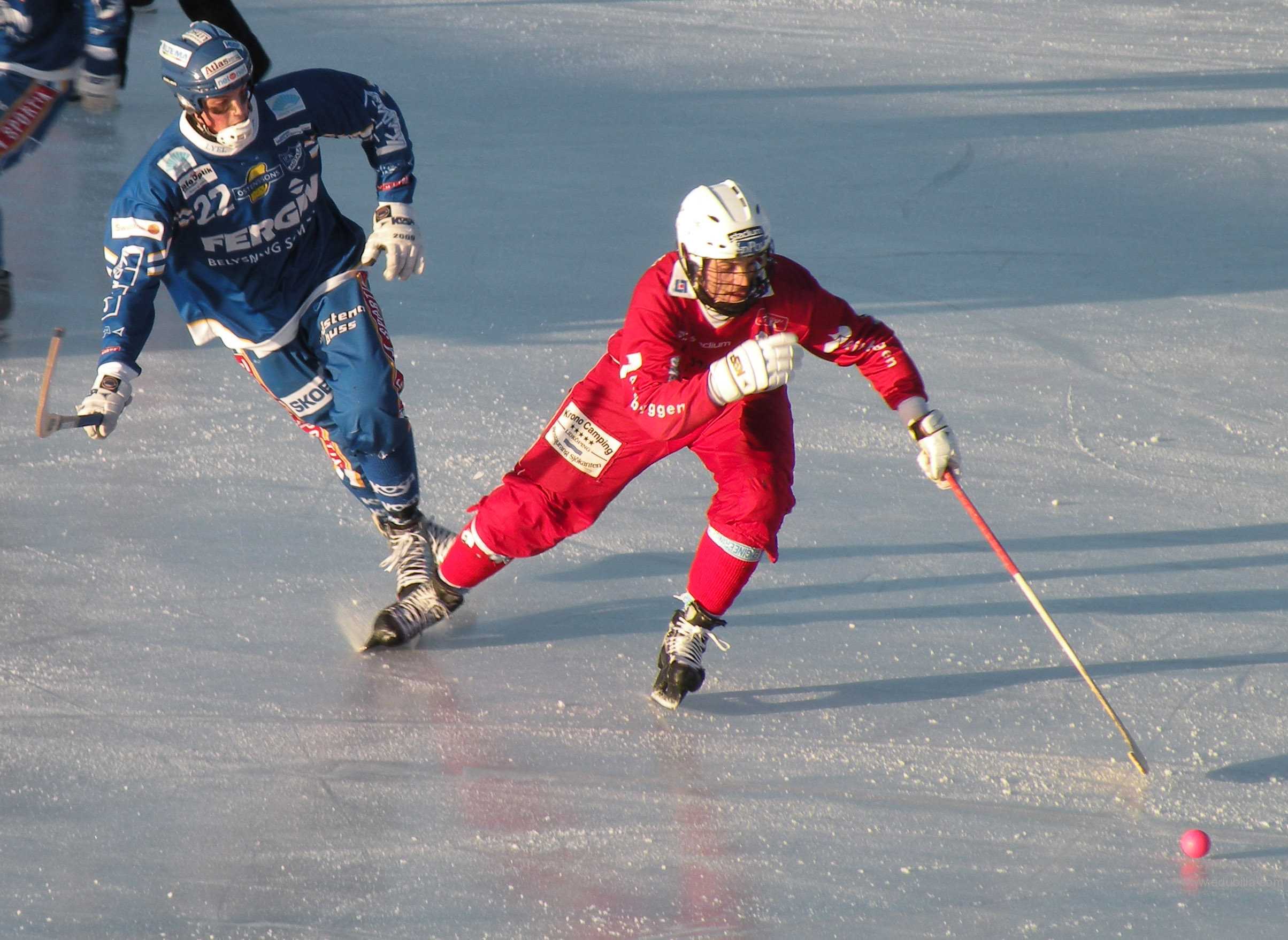
Overview Of Bandy
Bandy is a team winter sport played on ice, in which skaters use sticks to direct a ball into the opposing team's goal.
The sport has common background with association football, ice hockey and field hockey. Like football, the game is normally played in halves of 45 minutes each (however, in the World Championships the halves can be 30 minutes each), there are eleven players on each team, and the bandy field is about the same size as a football pitch. It is played on ice like ice hockey, but like field hockey, players use bowed sticks and a small ball.
If it is very cold or if it is snowing, the match can be broken into thirds of 30 minutes each.
A variant of bandy, rink bandy, is played to the same rules but on a field the size of an ice hockey rink and with fewer people on each team. Bandy is also the predecessor of floorball, which was invented when people started playing with bandy sticks and light balls when running on the floors of indoors gym halls.
Game Rules
Overview:
There are eighteen rules in official play. The same rules are designed to apply to all levels of bandy, although certain modifications for groups such as juniors, seniors or women are permitted. The rules are often framed in broad terms, which allow flexibility in their application depending on the nature of the game. The rules can be found on the official website of the Federation of International Bandy
Players and officials:
Each team consists of a maximum of 11 players (excluding substitutes), one of whom must be the goalkeeper. A team of fewer than eight players may not start a game. Goalkeepers are the only players allowed to play the ball with their hands or arms, but they are only allowed to do so within the penalty area in front of their own goal. Though there are a variety of positions in which the outfield (non-goalkeeper) players are strategically placed by a coach, these positions are not defined or required by the rules of the game.
The bandy stick:
The stick used in Bandy is a natural part of the sport. The stick should be made of an approved material such as wood or another similar material and it should not contain any metals or sharp parts which can hurt the surrounding players. The bandy stick should be crooked and the bend of the blade is split up into 5 different dimensions, where 1 has the smallest bend and 5 has the most. Bend 4 is the most common size in professional bandy. The bandy stick should not have similar colours to the ball, such as orange or pink; it should be no longer than 127 centimetres (50 in), and the breadth should not exceed 7 centimetres (2.8 in).
Field:
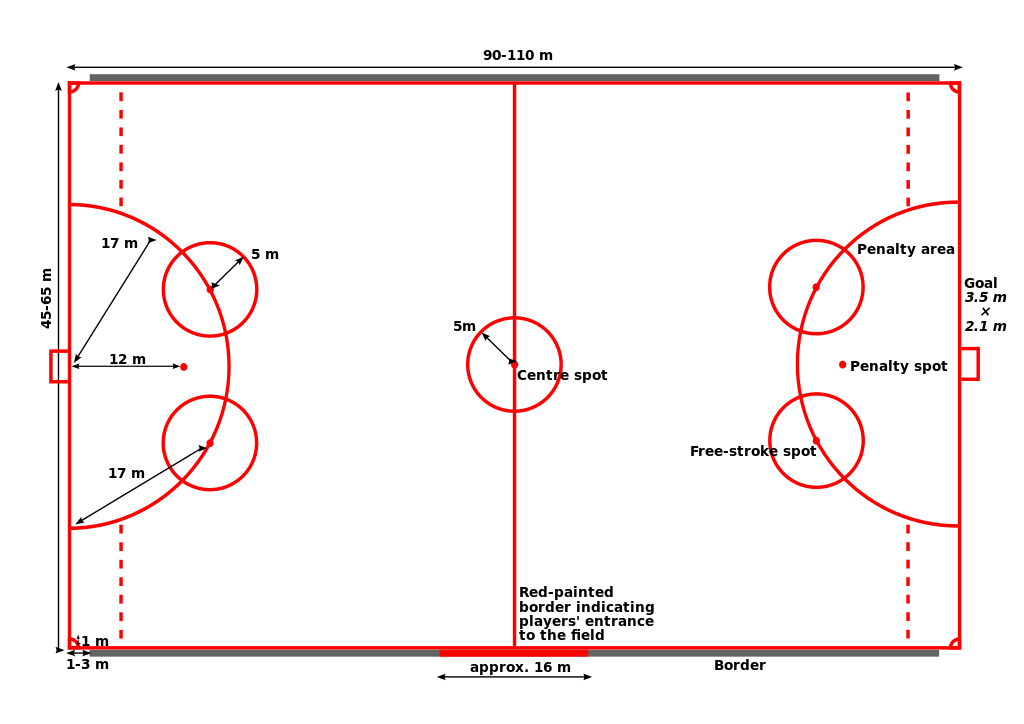
The size of a bandy field is in the range 4,050–7,150 square metres (43,600–77,000 sq ft) (45–65 metres (148–213 ft) by 90–110 metres (300–360 ft)), about the same size as a football pitch and considerably larger than an ice hockey rink. Along the sidelines a 15 cm (6 in) high border (vant, sarg, wand, wall) is placed to prevent the ball from leaving the ice. It should not be attached to the ice, to glide upon collisions, and should end 1–3 metres (3 ft 3 in–9 ft 10 in) away from the corners.
Centered at each shortline is a 3.5 m (11 ft) wide and 2.1 m (6 ft 11 in) high goal cage and in front of the cage is a half-circular penalty area with a 17 m (56 ft) radius. A penalty spot is located 12 metres (39 ft) in front of the goal and there are two free-stroke spots at the penalty area line, each surrounded by a 5 m (16 ft) circle.
A centre spot denotes the center of the field and a circle of radius 5 m (16 ft) is centered at it. A centre-line is drawn through the centre spot and parallel with the shortlines.
At each of the corners, a 1 m (3 ft 3 in) radius quarter-circle is drawn, and a dotted line is painted parallel to the shortline and 5 metres (16 ft) away from it without extending into the penalty area. The dotted line can be replaced with a 0.5-metre (1 ft 8 in) long line starting at the edge of the penalty area and extending towards the sideline, 5 metres (16 ft) from the shortline.
Ball in and out of play:
Under the rules, the two basic states of play during a game are ball in play and ball out of play. From the beginning of each playing period with a stroke-off (a set strike from the centre-spot by one team) until the end of the playing period, the ball is in play at all times, except when either the ball leaves the field of play, or play is stopped by the referee. When the ball becomes out of play, play is restarted by one of six restart methods depending on how it went out of play:
Stroke-off:Following a goal by the opposing team, or to begin each period of play.
Goal-throw:When the ball has wholly crossed the goal line without a goal having been scored and having last been touched by a member of the attacking team; awarded to the defending team.
Corner stroke:When the ball has wholly crossed the goal line without a goal having been scored and having last been touched by a member of the defending team; awarded to attacking team. The defending team must locate themselves behind goal line and the attacking team must be situated outside the penalty area with everyone but the executor no closer to the shortline than 5 m. As soon as the corner is shot, the attackers may enter the penalty area and the defenders may rush to try to stop the ball.
Free-stroke:Awarded to fouled team following certain listed offences, or to the opposing team upon a team causing the ball to leave the field over the side-line.
Penalty shot:Awarded to the fouled team following a foul usually punishable by a free-shot but that has occurred within their opponent's penalty area.
Face-off:Occurs when the referee has stopped play for any other reason (for example, a serious injury to a player, interference by an external party, or a ball becoming defective). This restart is uncommon in adult games.
Warnings and penalties:
Blue: 10 minutes penalty, red: match penalty.
A ten minutes penalty is indicated through the use of a blue card and can be caused by protesting or behaving incorrectly, attacking an opponent violently or stopping the ball incorrectly to get an advantage.
The third time a player receives a penalty, it will be a personal penalty meaning he or she will miss the remainder of the match. A substitute can enter the field after five or ten minutes. A full game penalty can be received upon using abusive language or directly attacking an opponent and means that the player can neither play nor be substituted for the remainder of the game. A match penalty is indicated through the use of a red card.
Detailed Bandy Rules Can Be Downloaded From Documents
Equipments Need For Bandy
Bandy ball:
Before each game, the organizers will show the referees in charge that they have at least 20 approved balls.
Accepted bandy balls are as follows:
-Kosa 60 mm
-Kosa 63 mm
-Jofa 60mm
-Jofa 62.4 mm
-Russian ball 63.8 mm.
Ball Color: The following ball colors are approved: dark red, orange and cerise (pink). It is not allowed to mix different kinds of balls or colors in a single game.
Bandy stick:
The sticks may have a maximum length of 127.0 cm. The length is measured along the outer side of the stick’s bend. Maximum thickness of the blade is 1.2 cm. The stick’s blade should over the entire blade have a minimum width of 5.3 cm and a maximum width of 7.0 cm including winding. The blade radius should have a maximum outer radius of 575mm (57.5 cm). The stick’s blade may NOT be straight anywhere, maximum radius is thus 575mm (57.5 cm). The tip of the blade should 1.0 cm into the blade have a width of at least 5.3 cm.
Bandy skates:
All players and officials on the ice must be wearing skates. These may not be equipped with sharp tips or others that might be of danger to others.The corners of the skate blade should be well rounded. Radius of rounding should be at least 5 mm. The blade must have a minimum thickness of 2.9 mm.
Helmets and Mouthguards:
All players and referees in games arranged by FIB are required to wear
head protection. Such head protection (helmets) shall be approved by FIB and bearing the approval mark (CE Mark). For field players are mouthguards mandatory. Jofa mouthguard (“old” mouthgard) or CE approved mouthguard that is applied inside the mouth is allowed to use.Mouthpiece molded and shaped by the dentist is allowed.
Goalie Pads:
Goalie Pads may have a maximum width of 30.5 cm and a maximum height of 80 cm. The dimensions are measured when the pads sit on the goalkeeper (so-called optical measurement).
Neck Guard:
Neck Guard is mandatory for all players.Protection must be CE marked.
Face Mask for Goalkeepers:
Face protection is compulsory for goalkeepers (CE approved). ?hanges to the facial protection is prohibited.Test blade (6 x 53 mm) shall not be possible to get through the protection
Goalie Gloves:
The goalkeeper may wear gloves with the following principles:
a) The gloves should in its form look like a normal leather glove.
b) The gloves should be provided with five fingers separated from each other.
c) The gloves may be provided with protective materials, such as foam rubber or similar material, but only on the fingers and the glove’s inside.
d) The contours around the glove’s fingers and hand may be a maximum of 1 cm.
History Of Bandy
Bandy as a precursor to ice hockey has had some influence on hockey's development and history – mainly in European and former Soviet countries. While modern ice hockey was created in Canada, a game more similar to bandy was played initially, after British soldiers introduced the game in the 19th century. At the same time that modern ice-hockey rules were formalized in North America, bandy rules were formulated in Europe. A cross between English and Russian rules developed, with the football-inspired English rules dominant, together with the Russian low border along most of the two sidelines.
Before Canadians introduced ice hockey into Europe in the late 19th century, "hockey" was another name for bandy, and still is in parts of Russia and Kazakhstan.
Names of the sport:
The sport’s English name comes from the verb "to bandy," from the Middle French bander ("to strike back and forth"), and originally referred to a 17th-century Irish game similar to field hockey. The curved stick was also called a "bandy."
Old names for bandy are hockey on the ice or hockey on ice. Since the mid-20th century the term bandy is usually preferred to prevent confusion with ice hockey.
The sport is known as bandy in many languages though there are a few notable exceptions. In Russian bandy is called "Russian hockey" or more frequently "hockey with a ball" while ice hockey is called "hockey with a puck" or more frequently just "hockey". In Belarussian, Ukrainian and Bulgarian it is also called "hockey with a ball" . In Kazakh bandy is known as "ball hockey" . In Finnish the two sports are distinguished as "ice ball" and "ice puck" . In Estonian and Hungarian, bandy is also called "ice ball" , although in Hungarian it is more often called "bandy" nowadays.
First Bandy match:
The first match, which later has been dubbed the original bandy match, was a match held at The Crystal Palace in London in 1875. However, at the time, the game was called "hockey on the ice",probably as it was considered an ice variant of field hockey.
First Olympic Games:
Bandy was held as a demonstration sport at the 1952 Winter Olympics in Oslo.
The Olympic bandy games were noticed by the sports leaders from the Soviet Union, who invited the thee Nordic countries to a friendly four nation bandy tournament in 1954. The first Bandy World Championship were not held until five years later, in 1957.
Bandy in India:
India has a national bandy team. Bandy Federation of India takes care of bandy in India. Its headquarters is in Mandi in Himachal Pradesh. Bandy is generally played in northern India where there is generally snow and ice. India is one of 6 countries in Asia and in total 28 to be a member of Federation of International Bandy. BFI planned to send a team to the tournament in Astana-Almaty 2011,but ultimately did not.
Origin Of Bandy
Bandy may have originated in England, circa 1790, mainly in the low-lying districts of Cambridgeshire and Lincolnshire
Bandy Club:
The first modern Bandy Club appears to have been that of Bury Fen Bandy Club in the Northeast of England. Some well-known football (soccer) clubs,
such as Sheffield United and Nottingham Forest, originally had bandy in their title as well as football (Nottingham Forest was once the Nottingham Forest Football and Bandy Club). The creation of the English Bandy Association came about in 1891. The first international meet also occurred in 1891 when Bury Fen opposed the Dutch Club of Haarlem. The game was soon superseded in England by ice hockey and is little played there today.
First World championships:
The Bandy World Championship for men were first held in 1957 and then every two years starting in 1961, and every year since 2003. Currently the record number of countries participating in the World Championships is 17. The participating countries vary from year to year. Finland won the 2004 world championship in Västerås. All other championships have been won by the Soviet Union, Russia, or Sweden.
First Bandy players:
Bandy was introduced to Sweden in 1895. The Swedish royal family, barons and diplomats were the first players. Swedish championships for men have been played annually since 1907. In the 1920s students played the game and it became a largely middle class sport. After Slottsbrons IF won the Swedish championship in 1934 it became popular amongst workers in the smaller industrial towns and villages. Bandy remains the main sport in many of these places.
First International Match:
The first international match took place in 1891 between Bury Fen and the then Haarlemsche Hockey & Bandy Club from the Netherlands (a club which after a couple of club fusions now is named HC Bloemendaal). The same year, the National Bandy Association was started in England.
Governing Bodies
Federation of International Bandy (FIB):
The Federation of International Bandy (FIB) is the international governing body for the sport of bandy, including the variant called rink bandy.
The federation was formed in 1955 in Stockholm, Sweden, and has had its base in Sweden since 1979. The present office is situated in Söderhamn, headed by FIB Secretary General Bo Nyman. Boris Skrynnik is the FIB President.
The name was from 1957 "The International Bandy Federation." At the Congress in Budapest/Hungary in 2001 the name was changed to "Federation of International Bandy" according to a request from IOC the same year, with reference to our approval as "recognized sport". The acronym IBF was occupied.
The purposes of FIB are:
In 2011, FIB formulized its purposes as being the following.
FIB vows to completely share the principles and articles of the Olympic Charter in its activities, including the policy with regard to anti-doping controls.
FIB wants to promote the development of the sports of bandy and rink bandy in the member countries and wants to carry on propaganda for the importance and advantages of these sports. FIB also works for bandy to become an olympic sport.
FIB declares itself to be an "independent autonomic mainsports organization which mainly is governing bandy activities all over the world".
FIB leads and supervises bandy and rink bandy around the world. FIB also sees as its job to settle the rules for the games.
One national member association should be entrusted by FIB with arranging an official world championship. FIB means that at least four nations must participate for it to be worth an event.
FIB also wants to promote the introduction and the membership of new nations to the organisation.
Presidents:
The following persons harve been presidents of FIB:
1955 – 1963, Gunnar Galin, Sweden
1963 – 1967, Allan Yungquist, Finland
1967 – 1971, Arne Argus, Sweden
1971 – 1978, Grigory Granaturov, Soviet Union
1978 – 1983, Pontus Widén, Sweden
1983 – 1991, Grigory Granaturov, Soviet Union
1991 – 1993, Carl Fogelberg, Finland
1993 – 1997, Staffan Söderlund, Sweden
1997 – 2005, Albert Pomortsev, Russia
2005 – 2005, Seppo Vaihela, Sweden
2005 – Boris Skrynnik, Russia
To Visit FIB Click Here
Awards Related To Bandy
The George Bandy Memorial Conference All-Sports Award:
The George Bandy Memorial Conference All-Sports Award is presented annually in the spring to the conference school who has amassed the most points awarded based on league finish in each sport.
USA Bandy Player of the Year award:
The 2011-2012 USA Bandy Player of the Year award was also announced on Saturday, and Mike Hosfield of Mississippi Mojo was the unanimous recipient of the award, given to the USA Bandy League's Most Valuable Player.
NCBCA's top player award:
Haggerty becomes first to win NCBCA's top player award three times
Fresno State senior P.J. Haggerty and Pikeville junior Kayla Bandy were named Most Valuable Players for the 2006-07 collegiate bowling season by the National Collegiate Bowling Coaches Association.
-Michael Jordan

